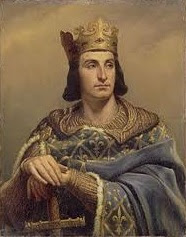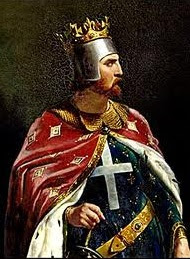Formation of National Monarchies
National monarchies of France
The political history of Lower Middle Ages is linked to the evolution of French, English and German monarchies, and relations between them and the Papacy.
In France, the kings of Dynasty Capetíngios, who ascended the throne in 987, at first did not impose a strong authority over his vassals. In 1066, a great French master, William the Conqueror, Duke of Normandy, seized the crown of England, after winning the Anglo-Saxon King Harold II. This event created a paradox within the feudal hierarchy. As king of England, William became overlord of the English lords. But, as the Duke of Normandy, it was still a vassal of the king of France.
The situation was further complicated with the rise to the English throne of Henry II, one of William relative who was the greatest feudal lord of France.
The strengthening of royal authority and the reaction against the English power in France began withFelipe Augusto (1180-1223). This sovereign entered the royal domains (territories under the direct authority of the king, without the interposition of feudal lords) large part of French fiefdoms owned by the kings of England. These annexations were consolidated by the Battle of Bouvines (1214), in which Felipe Augusto won a decisive victory over the English king John Landless and his ally, the German emperor Otto IV.
Felipe Augusto held an important administrative work and created real bailiffs - employees who collected taxes and distributing justice. Incidentally, the term bailiff was already applied in some regions of Europe, the agents of feudal lords who performed those functions.
Louis IX (1226-1270), later canonized, organized the real justice and instituted the right to appeal to the king's court, by those who were convicted in a feudal court. Philip IV the Fair (1285-1314), continued to expand the royal domains and strengthened their finances to confiscate the property of the religious order and military Templar.
Following advice of his forensic (legal experts who theorized about the power and rights in rem), Philip clashed with the Papacy, opposing the supremacy of spiritual power over the temporal. Excommunicated by Pope Boniface VIII, he sent troops to Italy to arrest him. After the death of Boniface, the cardinals elected Clement V, a French pope turned to Philip and in 1309, moved the seat of the Papacy to the French city of Avignon - a situation that would last until 1378 and would be known for Captivity name Avignon .
The sons of Philip the Fair, succeeded on the throne until 1328, leaving no male heirs. When the last of them died, the crown passed for Felipe nephew of the Fair, who started thedynasty of Valois with the name of Philip VI.
National monarchies of England
Henry II (1154-1189) ruled with a strong hand, imposing the barons (generic name of the great English lords; in other countries, the title of baron was part of the gentry, which is below the viscount and above Knight) . He tried to control the Church in England, seeking tosubmit it to the royal courts; but he found the firm opposition of the Archbishop of Canterbury, Thomas Becket, who was murdered for it. The Pope responded by launching an interdict on England and Henry stepped back, humbling in a public ceremony before Becket's tomb.
Ricardo Heart of Leon (1189-1199) was concerned more with the Third Crusade than with political and administrative matters. He was succeeded by his brother John Landless (1199-1216), an awkward ruler, whose attempt to dispose of ecclesiastical offices in England failed. Clashed with Pope Innocent III, who excommunicated him and transferred the English crown to the King of France, Philip Augustus. When Philip was preparing to invade England, John Landless submitted to the pontiff.
At this point, Felipe Augusto already hadannexed to his dominions various fiefdoms that the English kings had in France. After the Battle of Bouvines, the English barons rebelled and imposed John Landless the Magna Carta(1215). This important document ensured the lay and ecclesiastical lords many rights, among which stood out two: the king was prohibited from creating taxes and fees without the consent of the Grand Council of the Kingdom ( a body made up of bishops and barons), and the nobles accused of crimes would be tried by a jury of their peers.
The son of John Landless, Henry III (1216-1272), refused to respect the Constitution.Bishops and barons again rebelled and the Grand Council of the Kingdom, now calledParliament , the king imposed the Provisions of Oxford (1258), which effectively put the government in the hands of the nobility.
Years later, Henry III tried to regain his power, but was defeated and fell prisoner. Simon de Montfort (Anglo-French nobleman, winner of the son of the Albigensian heretics), leader of the barons, then called the Long Parliament(1265). Attending this meeting the prelates and barons and also for the first time, two knights (members of the gentry) by county and representatives of the bourgeoisie. This was the first Parliament with truly national character which met in England.
Parliament then became a fairly convened institution. In 1350, he became bicameral, divided into the House of Lords , formed by members of the high clergy and the nobility, and the House of Commons . The first was forlife and hereditary (except in the case of bishops, by being forced to clerical celibacy).The second, composed of knights and burghers, was elective and its members had a temporary mandate. Starting as a supervisory assembly and controlling the real power, Parliament would become the legislative body of England.
Thus, while France walked toward absolutism, England tended to be a limited monarchy, that in the eighteenth century would become parliamentary.
The evolution of the Holy Roman Empire
Closely linked to the Papacy since its foundation, the Holy Roman Empire exercised a certain supervision over the popes to theQuestion of the Endowment . After the Concordat of Worms (1122) ended the confrontation with advantage to papal authority, conflicts between the Empire and the Papacy began to revolve around the claims of both the area of Italy. In this new context, the emperor more engaged against the papal policy was Frederick II (1215-50).
Frederick, who united the titles of German Emperor, King of Naples, Sicily and also of Jerusalem (the latter acquired during the Sixth Crusade and only honorific), intended to restore imperial control over the northern urban centers of Italy, which they had become virtually independent. To preserve their freedom, these cities formed against Frederick the Lombard League , supported by the Papacy. Others, however, feared more papal power that the imperial and positioned themselves in favor of the German monarch.Communities connected to the pope against the emperor formed the party of the Guelphs, while their opponents were known by the Ghibellines name.
The fight between the two groups prevented if implanted a strong authority in Italy and led to the multiplication of small states, sometimes no larger than a city.
Frederick II was the last great emperor ofHohenstaufen Dynasty . When this family was extinguished in 1268, the Holy Roman Empire came to be elected. Emperors varied families succeeded on the throne until 1437, when voters princes must choose only members of the Habsburg dynasty , originally from Austria.
Please Share
Category: General history














0 komentar